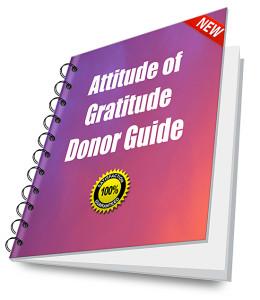 Giving is an emotional experience. It deserves an emotional response.
Giving is an emotional experience. It deserves an emotional response.
Be human.
Ever notice how sometimes when we put on our work hats we cease to be human? How we somehow morph into little robotic “professionals” and become enamored of jargon?
“Lybnts.” “Sybnts.” “Recaptures.”
Not that those things aren’t important. You need goals and objectives.
And given the dreadful state of donor retention in the U.S. today (and in the U.K and Canada as well), it’s vital you be able to measure how you’re doing. Because growth in giving is a factor not just of how many new donors and dollars you acquire, but also of how many donors and dollars you lose.
If you lose as many current donors as you gain new ones, you’re getting nowhere. Fast.
Treadmills Are Only Good in the Gym
Slow down.
Think about what you’re doing and why. You may need to change your frame of mind.
When you acquire a new donor, is it for that one-time transaction? If so, that’s not a very thoughtful strategy, because it costs more money than you make to acquire new donors. In fact, you likely won’t make back your investment for 18 months or so. You won’t make it back at all if you don’t renew that donor.
Nonprofits, sadly, have been on a non-stop treadmill. Donors in. Donors out. Donors in. Donors out. So… something about just measuring this stuff isn’t really working.
Alas, you must invest for lifetime value if you want to see a pay-off. Commercial businesses understand this and incorporate this reality into their plans and budgets.
EXAMPLE: Starbucks knows if they invest $1,000 in a new customer that customer will yield $14,000 over their lifetime. So investing this amount in marketing to create a positive customer experience makes sense. The same holds true for donors.
Before we get to some possible (very human) nonprofit solutions, let’s take a look at the data.
The Dismal State of Nonprofit Donor Retention
The annual “Fundraising Effectiveness Project” report reveals the dismal state of average donor retention:
- Only 43% of all donors renew.
- Only 21% of new donors renew.
- For every 100 donors acquired, 105 are lost to attrition.
- Every $100 gained was offset by $93 in losses.
- Average dollar retention is just 47%.
Donor and dollar retention rates have averaged below 50% for well over a decade.
If we’ve known this for this long, why aren’t things improving?
The two fundamental reasons donor retention is so miserable:
- Nonprofits don’t take time to actively make friends.
- Nonprofits don’t take time to then be a good friend.
I often say: “The number one reason folks don’t give is they aren’t asked. The number one reason they don’t give again is because you didn’t ‘make nice.’”
It sounds simple, I know. But ask yourself how much of your day you spend really doing this?
Would you like some strategies to help you activate you friendship building strategy? I’ve got five of them for you! But first, allow me to share a couple of secrets that will get, and keep, you in the right frame of mind to do this work.
2 Friendship-Building Secrets to Build Donor Loyalty
1. Actively make friends.
Let me illustrate how this is done with a story about my daughter.
She happens to be an introvert. She’s also an empath. And something in her brain clicked on her first day of high school. She intuitively understood everyone was in the same boat as she was. No one had friends. Everyone felt uncertain as to how much they would be welcomed into their new community.
So she went up to strangers and:
- She invited engagement.
- She showed interest in them.
- She listened to them.
- She drew them out and didn’t make it about herself.
How much do you do these things with your would-be and current donors?
Within a week’s time my daughter had a cadre of loyal friends. They became more loyal every day.
Why?
Because she also actively does something else.
2. Be a good friend.
What do good friends do?
- They regularly think about each other.
- They call each other up.
- They invite each other out.
- They share items of interest.
- They give each other gifts.
- They support each other when times are bad.
- They celebrate each other’s successes.
- They accept one another.
- They are honest and self-revelatory with each other.
How much do you do these things with your donor friends?
This is really not rocket science folks.
You simply must commit to making this a priority.
5 Action Tips to Make and Keep Friends (aka Donors)
1. Start with a sincere thank you to your friend.
Thank you is the first and most important step to building loyalty.
According to Penelope Burk, the three things donors most want from charities all have to do with thank you. They want it (1) prompt, (2) personal and (3) powerfully demonstrative of the impact of their philanthropy. Did you know 13% percent of donors leave because the nonprofit didn’t say thanks ?
Donors need to know:
- You got the gift.
- You put it to work as the donor intended.
- You follow through.
- You’re efficient.
- You have manners.
- You’re trustworthy.
- You appreciate the thought and emotion that went into giving this gift.
- You’re committed to making your donors happy.
One way to assure you are warm, sincere and prompt is to make a thank you call. You can send the letter a bit later. Grab a free guide on how to make these calls here.
2. Never stop thanking your friend.
Gratitude, to be effective, must be repeated. You truly cannot thank people too much.
While the donor may feel momentarily satisfied by the thank-you letter sent following their gift, this satisfaction won’t remain for long. They’ll start to wonder if their gift is really having an impact. They’ll wonder if you still remember them or if anyone there knows they’re a donor. Are they important to you as a person or just another wallet?
I advocate sending thank-yous from multiple contacts at your nonprofit:
- Dole these out over time.
- One from the executive director today.
- One from the program director three weeks later.
- One from someone who was helped a month after that.
- And so forth.
A practice of continuous gratitude, expressed by different people, helps the donor feel part of your extended family and community. It has the added benefit of assuring your donor will remain connected should their primary contact leave the organization.
3. Flatter your friend.
You can’t do this too much.
You know the old adage “flattery will get you everywhere?” Adages exist because they’re largely true. The best way to flatter a donor is to remind them—over and over—“You made this possible.”
- Flatter them specifically in writing in a thank you letter, thank you landing page, email, text or social media shout-out. “Claire, I think what you did was exceptional.”
- Flatter them generally in writing in a newsletter, blog post, annual report or other print publication heaping gratitude on all your supporters who make your mission possible. “I believe all the individuals involved in our network are pretty special, and I wish I could thank each and every one of you in person.”
- Flatter them generally during an in-person or virtual event where you thank your supporters and call them out as superstars. “If you’re a donor, please raise your hand. Folks, you are looking at the heart and soul of our mission. These people are exceptional. Let’s give them a hand!”
People like knowing you appreciate them. If you don’t “do the woo,” I can guarantee you someone else will. The philanthropy marketplace is crowded with other suitors.
4. Creatively demonstrate the impact your friend has on you.
Come up with different ways to show your donors the impact of their giving. Help them to see, feel, hear, touch and even smell your work.
Here are a few ideas:
- Snapshot of your work in action.
- Video of your work in action.
- Letter/card/drawing from a recipient of services.
- Event where clients attend and donors can hear from them directly.
- Hands-on volunteer activity where donors can participate in your mission.
5. Give gifts to your friend.
Show your donors you’re thinking of them. Often.
Gifts needn’t be tangible or expensive stuff. Little gifts of token content are swell. Or you can offer experiences. For example:
- How-to” posts
- Recommended reading lists
- Articles of interest
- Stories
- Stickers
- Coupons
- Certificates
- Recipes
- Behind-the-scenes tours
- Fireside chats
- Town halls
- Volunteer activities created just for donors
Absence does not make the heart grow fonder. Brainstorm “little wows” your donors will find enchanting.
Commit to Creating a Friendship-Building Plan
Whether your donor is new or ongoing, your job is to keep your organization and mission top of mind.
Loyalty is earned. So commit to developing your own donor loyalty plan. Write down your goals (why), objectives (how) and strategies (who, what, where and when). Assign some resources to see it through!
Plan your dive; dive your plan. That’s by far the best way to assure your donors will be in a receptive frame of mind when you next approach them for a favor (aka, donation).
Want More Donor Retention Action Tips?
 Get the Attitude of Gratitude Donor Guide. I’ve taken everything I’ve learned about sustaining donor relationships over the years and tucked it into one handy no-nonsense guide on the practice of gratitude. It also includes sample templates, worksheets and my Creative Ways to Thank Your Donors guide with 72 ideas you can use!
Get the Attitude of Gratitude Donor Guide. I’ve taken everything I’ve learned about sustaining donor relationships over the years and tucked it into one handy no-nonsense guide on the practice of gratitude. It also includes sample templates, worksheets and my Creative Ways to Thank Your Donors guide with 72 ideas you can use!
Within the 130 pages you’ll find everything from how to persuade your leadership of the value of putting resources into prompt, personal thanks to… how to create a meaningful thank you email… to how to thank your donors on social media. It’s all in here. The tried-and-true and the dare-to-try! If you read this guide, and use it, you’ll raise more money every year from here on out. And if you’re not happy, there’s a 30-day, no-questions-asked, 100% refund guarantee.
Photo by Ben White on Unsplash.
Some material in this article appeared originally on Nonprofit Pro, May 2017






I describe you to others in need of your advice as my go-to fundraising guru. You are so right about the power of thank yous in retention. As a now retired but now volunteer fundraiser, I look most critically at the thank you and the follow-up to my donations. I contact organizations to both praise or critique their response. I consider it one way to use my experience for their betterment and to ensure I continue to invest in causes I support.
Thanks for your kind words and sage advice Susan. Keep paying it forward!